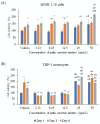Evaluation of bone-protecting effects of palm carotene mixture in two- and three-dimensional osteoblast/osteoclast co-culture systems
- PMID: 39898246
- PMCID: PMC11783079
- DOI: 10.7150/ijms.103445
Evaluation of bone-protecting effects of palm carotene mixture in two- and three-dimensional osteoblast/osteoclast co-culture systems
Abstract
Background: Carotene exists naturally in a complex mixture consisting of alpha (α), beta (β), and gamma (γ)-isoforms. Previous studies investigated the effects of individual carotene isomers on bone rather than their actions in a mixture. Purpose: This study explored the bone-protective properties of palm carotene mixture using both two- and three-dimensional co-culture systems. Study design: The viability of human foetal osteoblasts (hFOB 1.19), viability of human monocytic cell line (THP-1), osteoblast differentiation, osteoclast maturation, bone quality and strength were assessed in two- and three-dimensional co-culture system after treatment of palm carotene mixture. Methods: The viability of hFOB 1.19 and THP-1 was determined on day 1, 3, and 6 following treatment of palm carotene mixture. The osteoblast-osteoclast co-culture (ratio of hFOB 1.19 to THP-1 = 2:1) was treated with palm carotene mixture as well as subjected to alkaline phosphatase (ALP) and tartrate resistant acid phosphatase (TRAP) staining on day 21 to assess the osteoblast proliferation and osteoclast maturation. Dual-energy X-ray absorptiometry, micro-computed tomography, universal testing machine, and bone histomorphometry were used to assess the bone parameters of scaffolds co-cultured with osteoblasts and osteoclasts. Results: Palm carotene mixture (3.13 - 50 μg/mL) increased osteoblast viability. Monocyte viability decreased in lower concentration (3.13 - 12.5 μg/mL) but increased in higher concentration (25 - 50 μg/mL) of palm carotene mixture. Treatment with palm carotene mixture (12.5 µg/mL) demonstrated earlier peak for the ALP-positive area on day 14 but decreased total number of TRAP-positive multinucleated cells on day 21. Palm carotene mixture also increased bone volume and osteoblast number in the three-dimensional co-culture system. Conclusion: Palm carotene mixture potentially exhibits beneficial effects on bone by accelerating osteoblast proliferation and suppressing osteoclast maturation. The findings of current study serve as the basis for the further validation through animal experiments and human trials.
Keywords: bone cells; bone remodeling; osteoporosis; provitamin A; scaffold.
© The author(s).
Conflict of interest statement
Competing Interests: The authors have declared that no competing interest exists.
Figures












Similar articles
-
Effects of extracellular magnesium extract on the proliferation and differentiation of human osteoblasts and osteoclasts in coculture.Acta Biomater. 2015 Nov;27:294-304. doi: 10.1016/j.actbio.2015.08.042. Epub 2015 Aug 28. Acta Biomater. 2015. PMID: 26318802
-
Effects of geranylgeranoic acid in bone: induction of osteoblast differentiation and inhibition of osteoclast formation.J Bone Miner Res. 2002 Jan;17(1):91-100. doi: 10.1359/jbmr.2002.17.1.91. J Bone Miner Res. 2002. PMID: 11771673
-
Icariin influences adipogenic differentiation of stem cells affected by osteoblast-osteoclast co-culture and clinical research adipogenic.Biomed Pharmacother. 2017 Apr;88:436-442. doi: 10.1016/j.biopha.2017.01.050. Epub 2017 Jan 22. Biomed Pharmacother. 2017. PMID: 28122309
-
Cellular and molecular effects of growth hormone and estrogen on human bone cells.APMIS Suppl. 1997;71:1-30. APMIS Suppl. 1997. PMID: 9357492 Review.
-
Osteoblast-osteoclast co-cultures: A systematic review and map of available literature.PLoS One. 2021 Nov 4;16(11):e0257724. doi: 10.1371/journal.pone.0257724. eCollection 2021. PLoS One. 2021. PMID: 34735456 Free PMC article.
References
-
- Park CK, Ishimi Y, Ohmura M, Yamaguchi M, Ikegami S. Vitamin A and carotenoids stimulate differentiation of mouse osteoblastic cells. J Nutr Sci Vitaminol. 1997;43:281–96. - PubMed
MeSH terms
Substances
LinkOut - more resources
Full Text Sources

